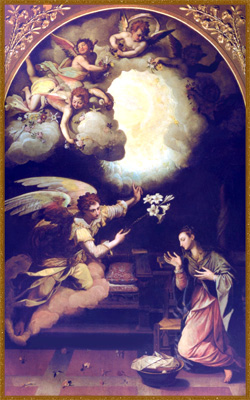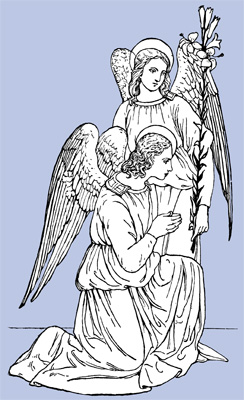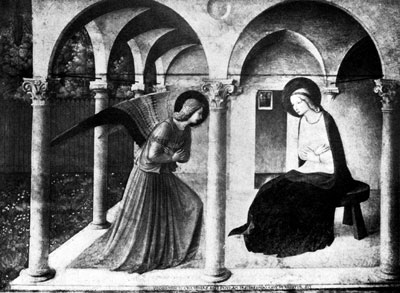 A very ancient Annunciation, of peculiar and elaborate arrangement, dating from the fifth century, is in mosaic, over the arch in front of the choir in the church of Santa Maria Maggiore, in Rome. The classical treatment of the dresses, and of the entire composition, makes this work so different from the usual conception of the subject as to be of observation. There are two scenes: in the first, the archangel is sent on his mission, and is rapidly flying towards the earth, as if in haste to utter his joyous salutation, “Hail! thou art highly favored! Blessed art thou among women!”
A very ancient Annunciation, of peculiar and elaborate arrangement, dating from the fifth century, is in mosaic, over the arch in front of the choir in the church of Santa Maria Maggiore, in Rome. The classical treatment of the dresses, and of the entire composition, makes this work so different from the usual conception of the subject as to be of observation. There are two scenes: in the first, the archangel is sent on his mission, and is rapidly flying towards the earth, as if in haste to utter his joyous salutation, “Hail! thou art highly favored! Blessed art thou among women!”
The second scene presents Gabriel standing before the Virgin, who is seated on a throne, behind which are two guardian angels. This representation is so utterly unlike what is known as Christian art as to make a lasting, impression, by reason of its classical treatment; all the details have an air of belonging to an earlier period than that known as medieval, and the figures might be those of ancient Greeks.
It is extremely curious and interesting to observe the various methods of representing the Archangel Gabriel in pictures of the Annunciation. At times he might be mistaken for the ambassador of a proud and powerful earthly potentate. He is clothed in gorgeous raiment, with a rich train, sometimes borne by one, and again by three page-like angels, while carries himself with majestic haughtiness
We do not wonder that the difference between the estate of an archangel sent by God, and the humility of the Virgin of Galilee, should have misled some artists, or that with them the angel held the first place, especially as it was only thus that any element of splendor could be introduced into their pictures. Indeed, we have engravings after a picture by Raphael, in which the Virgin is kneeling before the angel, who raises the right hand in benediction.
But the gradual increase in the veneration, accorded to the Virgin, and the title of Queen of Heaven, and Queen of Angels, which were bestowed on her, soon changed the spirit of the representations of the Annunciation; and while the Virgin loses none of her humility and submission, the angel bows, and even kneels, to her, thus emphasizing his acknowledgment of her superior holiness, since an archangel could only kneel before spiritual perfection.
It was well that the patriarchs and prophets should acknowledge the superiority of the angels sent to them, but the glory of the Mother of Christ should be represented as commanding the reverence of even the highest of created beings—only thus could the faith of the Church for which these religious pictures were painted, be fittingly illustrated.
Thus it became customary to omit the scepter in the hand of the angel, and to give him the lily alone, or the lily and the scroll. Indeed, there are notable pictures in which Gabriel has no symbol, but with hands clasped over his breast, and head inclined, he seems to worship the Virgin while declaring his mission to her. There are, however, few Annunciations in which the lily does not appear. It is the special symbol of the purity of Mary, to whom is applied the verse from the Song of Solomon: “I am the rose of Sharon, and the lily of the valleys.” In some pictures the lily is seen in a vase near the Virgin.
Occasionally the symbol of peace is introduced in pictures of the Annunciation by placing a crown of olive on the head of the archangel, or an olive branch in his hand. Here Gabriel is presented as announcing the “Peace on earth and good will towards men,” which Raphael and his attendant angels chanted to the shepherds on the birth of Jesus.
The early German painters were fond of picturing Gabriel in priestly robes, heavily embroidered, and rich in color. This dress supplied the same gorgeous effect as was given by the princely trains. In these pictures Gabriel usually kneels, his ample robes falling on the pavement around him, thus avoiding the proud bearing of the regally vestured messenger.
The simplicity of the scene, when Gabriel is appropriately draped in the filmy white robe, which is the usual conception of an angel’s dress, is far more satisfactory and harmonious with the spirit of the miraculous Annunciation than any splendid vestments can possibly be.
The earliest pictures of the Annunciation, however, in spite of unsuitable costumes, and of certain technical imperfections, are more acceptable to the reverent mind than are those of a later time, in which the angel is scantily draped and is apparently conscious of his physical beauty, while the Virgin is entirely wanting in grace or dignity. Such a rendering of this scene is most offensive; all the more so that these pictures are frequently well executed, and were they not presented as representations of this sacred subject, but given some appropriate title, they would have claims to a certain artistic approbation.
 The Annunciation by Alessandro Allori
The Annunciation by Alessandro Allori
Other artists, like Allori, in the illustration above, represent an all too conscious Virgin, an angel who apparently poses for a picture, and a mass of utterly inappropriate detail. This Annunciation, which is in the Florentine Academy, affords an excellent example of this objectionable style, and its faults are emphasized when it is compared with the serious dignity of Fra Filippo’s picture and that which follows, by Fra Angelico. By such comparisons the great difference between true sentiment and affectation in Art becomes apparent.
There are some Annunciations in which the Virgin is represented as starting up from fear or surprise, quite as one might fancy that a tragedy queen would do, were her privacy unceremoniously disturbed.
Again the Virgin Mary is fainting from emotion, and thus could not have replied to the angel in the Scriptural words, “Behold the handmaid of the Lord; be it unto me according to thy word.”
Not infrequently, in representations of this scene, the Holy Spirit, as a dove, hovers above or near the Virgin, or flies in through a window; again the Almighty is seen in the clouds, surrounded by a celestial light, and sometimes attended by celestial spirits. In rare instances the Eternal Father sends the Infant Jesus down from the sky bearing a cross, and preceded by a dove. These extremely symbolic Annunciations are usually of an early date.
Fra Angelico painted the Annunciation with intense reverence and simplicity. There is an illustration of his fresco on the wall of the corridor in his convent of San Marco, in Florence, which some believe is one of the most beautiful and spiritual Annunciations in existence. It tells the sacred story faithfully; there is nothing introduced that does not essentially belong here. The Virgin gives the impression of being equal to the angel in purity and goodness; he is superior only in knowledge.
Angelico believed that he was divinely directed in his work, which he began with prayer, and for this reason he would never change his original design. His care in the finish of his pictures was phenomenal; his draperies were dignified; his color and composition were harmonious. It has well been said of his works: “Every part contributed to that unity of tenderness, inspiration, and religious feeling which marks his pictures, and which are such as no one man had ever succeeded in accomplishing.”
Angelico knew nothing of human anxieties and struggles, and could not paint them; he could not depict the hatred of the enemies of Christ; martyrdoms and persecutions were feebly represented by him, but to annunciations, coronations of the Virgin, and kindred subjects he imparted a sweetness and a spiritual fervor that has rarely, if ever, been surpassed. We can imagine him rising from his prayers with his conceptions of the Virgin and the archangel as distinct in his mind’s eye as they are to our vision in his pictures, and it is easy to understand that the man who lived in his atmosphere would be void of ambition, and refuse to be made Archbishop of Florence, as he did.
Gabriel is reverenced by the Jews as the chief of the angelic guards and the keeper of the celestial treasury. The Mohammedans regard him as their patron saint; their prophet believed this archangel to be his inspiring and instructing spirit. Thus he is important in the faith and legends of Christians, Jews, and Mohammedans alike. Milton may have had the Jewish tradition in mind when he represented Gabriel as the guardian of paradise:
Betwixt these rocky pillars Gabriel sat,
Chief of the angelic awaiting night.
Source: Clement, Clara Erskine. Angels in Art. Boston: L. C. Page and Company, 1898.
Please visit Christian Image Source for more beautiful images of Archangel Art.

